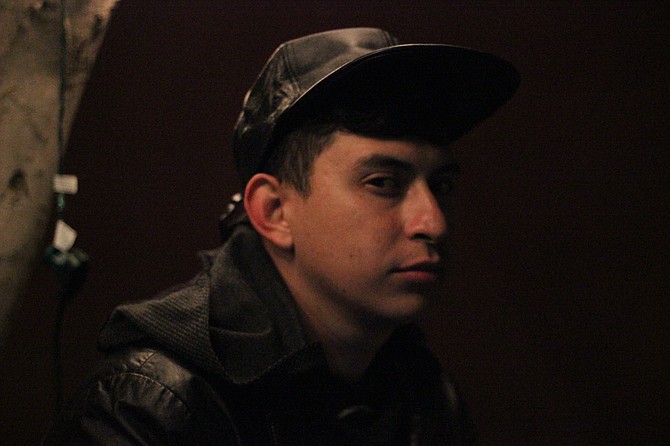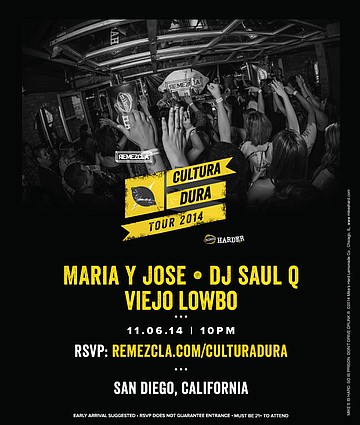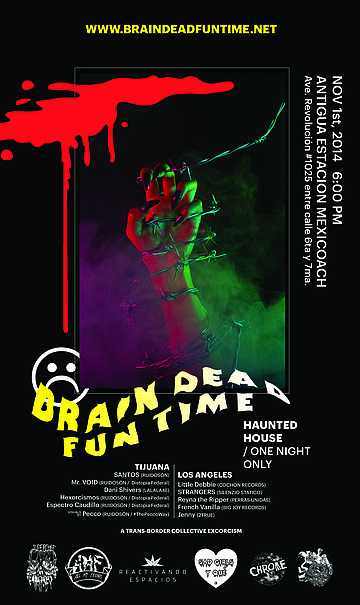 Facebook
Facebook
 X
X
 Instagram
Instagram
 TikTok
TikTok
 Youtube
Youtube

More of an attitude than a proper genre, a close-knit collective of Tijuana musicians put a significant blip on the international music radar starting in 2009 under the umbrella tag ruidosón.
The sound takes hints from styles as disparate as cumbia, krautrock, electro-folk, and hip hop, to name a few, but the unifying posture is a critical retort to corruption, violence, religion, and politics.
While Tijuana has been painted over as “revitalized” and “vibrant” by countless observers, ruidosón posits that a dark side still very much exists in Tijuana and throughout Mexico — a stance that was driven home last month when 43 students disappeared and another 6 were killed by police near Iguala, Guerrero.
Five years into the game, María y José aka Tony Gallardo II (one of ruidosón’s instigators and co-founder of Mexican/Venezuelan netlabel, Cocobass) will be performing for the first time in San Diego on Thursday, November 6 along with DJ Saul Q and Viejo Lowbo at U-31.
Entry is free with RSVP.
María y José’s most recent tune, “Plata o Plomo,” is a wonky, bass-heavy, inverse narcocorrido (ballad about drug-trafficking life) of sorts that riffs on the cartel threat of “silver or lead,” which is to say, “take money or a bullet.”
Pending his debut in San Diego, where he grew up in part, Gallardo talks with the Reader about Tijuana’s art & music scene and what ruidosón means today.
Chad Deal: Many of the ruidosón founders moved away to DF or other cities in the south. Recently, many seem to be returning to Tijuana. Where did you go, and what brought you back?
Tony Gallardo II: I'm living in Monterrey right now, but I'll be going back and forth to TJ because I'm having lots of US shows and it's easier for me to travel from SD to all these places. I hope to come back again one day and live full time, but not until my son grows up. I’ve played NY, Chicago, and LA, and maybe I'll be playing a Southwestern tour next year, but we're still trying to figure that out.
CD: What did you come to appreciate about Tijuana after leaving?
TG: Something is really happening, not just with the ruidosón guys, but as whole “scene.” Everybody is leaving jealousy behind and that's the first step to have union in every scene. I had the opportunity to attend the Bring Your Own Beamer project [an open-invitation projection art exhibition that took place in over 35 cities around the world] and it was awesome.
CD: How is it significant for you to be playing in SD as María y José for the first time?
TG: For me it's very important because I used to live there and it was part of me growing up. I'm so excited I finally can play and show the San Diegans what I'm made of.
CD: Do you see ruidosón as a product of the border region, equally influenced by what’s going on in SD and TJ, or is it a distinctly TJ sound?
TG: San Diego definitely had an impact on our music, you know, listening to hip hop on 90.3 or rock music on another station. I like to think of myself as a multi-cultural guy, a border guy. I am a proud Tijuanense, but I don't consider myself just Mexa.

CD: What has your latest material been looking at thematically?
TG: Violence and love. I'm writing some other stuff too. I want my lyrics to be thought of as a movie script, not just a song.
CD: What's in the future for you and ruidosón?
TG: María y José is always changing and is never going to bore people because I experiment a lot and it never sounds the same (but has my mark on it). A new LP is in the works but I don’t want to release it until I got a label backing it. Ruidosón is always creating new stuff. Everyone in the movement is so brilliant, so I think we are still gonna be pumping your parties up for quite some time.
CD: TJ is a much chiller place than when María y José began. In the absence of narco-violence in the streets, what are some of the dark sides that ruidosón stills calls out?
TG: We can talk about racial violence in the US (I have lots of friends who are involved in these topics and like to know what's going up everytime this happens). Violence in México, it's not just about Tijuana, it's about both countries.

You can check out more ruidosón on Saturday, November 1 at the Old Mexicoach Station between 6th and 7th on Revolucion, Tijuana.
Brain Dead Fun Time Haunted Maze is the first event of its scale to be held at the historic site in about a decade, as the building was recently reactivated by tech accelerator and co-working space HUB STN.
The interactive haunted house will be created by artists from Southern California and Baja to facilitate “a trans-border collective exorcism of state-sanctioned oppression.”
Tijuana musicians: Santos, Mr. Void, Dani Shivers, Hexorcismos, Espectro Caudillo, and more.
Los Angeles musicians: Little Debbie, French Vanilla, jenny, Strangers, Reyna the Ripper, and more.
5 dollars at the door.


More of an attitude than a proper genre, a close-knit collective of Tijuana musicians put a significant blip on the international music radar starting in 2009 under the umbrella tag ruidosón.
The sound takes hints from styles as disparate as cumbia, krautrock, electro-folk, and hip hop, to name a few, but the unifying posture is a critical retort to corruption, violence, religion, and politics.
While Tijuana has been painted over as “revitalized” and “vibrant” by countless observers, ruidosón posits that a dark side still very much exists in Tijuana and throughout Mexico — a stance that was driven home last month when 43 students disappeared and another 6 were killed by police near Iguala, Guerrero.
Five years into the game, María y José aka Tony Gallardo II (one of ruidosón’s instigators and co-founder of Mexican/Venezuelan netlabel, Cocobass) will be performing for the first time in San Diego on Thursday, November 6 along with DJ Saul Q and Viejo Lowbo at U-31.
Entry is free with RSVP.
María y José’s most recent tune, “Plata o Plomo,” is a wonky, bass-heavy, inverse narcocorrido (ballad about drug-trafficking life) of sorts that riffs on the cartel threat of “silver or lead,” which is to say, “take money or a bullet.”
Pending his debut in San Diego, where he grew up in part, Gallardo talks with the Reader about Tijuana’s art & music scene and what ruidosón means today.
Chad Deal: Many of the ruidosón founders moved away to DF or other cities in the south. Recently, many seem to be returning to Tijuana. Where did you go, and what brought you back?
Tony Gallardo II: I'm living in Monterrey right now, but I'll be going back and forth to TJ because I'm having lots of US shows and it's easier for me to travel from SD to all these places. I hope to come back again one day and live full time, but not until my son grows up. I’ve played NY, Chicago, and LA, and maybe I'll be playing a Southwestern tour next year, but we're still trying to figure that out.
CD: What did you come to appreciate about Tijuana after leaving?
TG: Something is really happening, not just with the ruidosón guys, but as whole “scene.” Everybody is leaving jealousy behind and that's the first step to have union in every scene. I had the opportunity to attend the Bring Your Own Beamer project [an open-invitation projection art exhibition that took place in over 35 cities around the world] and it was awesome.
CD: How is it significant for you to be playing in SD as María y José for the first time?
TG: For me it's very important because I used to live there and it was part of me growing up. I'm so excited I finally can play and show the San Diegans what I'm made of.
CD: Do you see ruidosón as a product of the border region, equally influenced by what’s going on in SD and TJ, or is it a distinctly TJ sound?
TG: San Diego definitely had an impact on our music, you know, listening to hip hop on 90.3 or rock music on another station. I like to think of myself as a multi-cultural guy, a border guy. I am a proud Tijuanense, but I don't consider myself just Mexa.

CD: What has your latest material been looking at thematically?
TG: Violence and love. I'm writing some other stuff too. I want my lyrics to be thought of as a movie script, not just a song.
CD: What's in the future for you and ruidosón?
TG: María y José is always changing and is never going to bore people because I experiment a lot and it never sounds the same (but has my mark on it). A new LP is in the works but I don’t want to release it until I got a label backing it. Ruidosón is always creating new stuff. Everyone in the movement is so brilliant, so I think we are still gonna be pumping your parties up for quite some time.
CD: TJ is a much chiller place than when María y José began. In the absence of narco-violence in the streets, what are some of the dark sides that ruidosón stills calls out?
TG: We can talk about racial violence in the US (I have lots of friends who are involved in these topics and like to know what's going up everytime this happens). Violence in México, it's not just about Tijuana, it's about both countries.

You can check out more ruidosón on Saturday, November 1 at the Old Mexicoach Station between 6th and 7th on Revolucion, Tijuana.
Brain Dead Fun Time Haunted Maze is the first event of its scale to be held at the historic site in about a decade, as the building was recently reactivated by tech accelerator and co-working space HUB STN.
The interactive haunted house will be created by artists from Southern California and Baja to facilitate “a trans-border collective exorcism of state-sanctioned oppression.”
Tijuana musicians: Santos, Mr. Void, Dani Shivers, Hexorcismos, Espectro Caudillo, and more.
Los Angeles musicians: Little Debbie, French Vanilla, jenny, Strangers, Reyna the Ripper, and more.
5 dollars at the door.
Comments